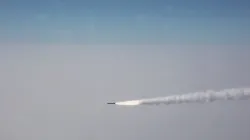India successfully tests anti-radiation indigenously developed Air to Surface Rudram-II missile
This is the second generation of the indigenously developed anti-radiation missile. The first generation of Rudram was test-fired successfully three years ago by Defence Research and Development.

India on Wednesday successfully flight tested anti-radiation indigenously developed Air to Surface RudraM-II missile from Su-30 MK-I off the Odisha coast. The flight test met all the trial objectives, validating the propulsion system, control and guidance algorithm, DRDO said in a post on social media platform X.
The missile, Rudram, is India's first indigenously developed anti-radiation weapon system and it was test-fired by the Defence Research and Development Organisation (DRDO), officials said.
They said the missile, having a speed of Mach two or twice the speed of sound, is capable of bringing down a wide-range of enemy radar systems, communication networks and air defence systems.
The test has established India's capability to develop long range air-launched anti-radiation missiles.
Three years ago, DRDO successfully tested the first generation of Rudram missile. Officials said the missile picks up signals from radiation emitting platforms and systems and neutralises them.
Defence Minister Rajnath Singh congratulated the DRDO on successful test firing of the missile, calling it a "remarkable achievement".
"New Generation Anti-Radiation Missile (Rudram-1) which is India's first indigenous anti-radiation missile developed by @DRDO_India for Indian Air Force was tested successfully today at ITR, Balasore. Congratulations to DRDO & other stakeholders for this remarkable achievement," he tweeted. The officials said the missile will be integrated into a batch of Su-30 MKI jets of the Indian Force once it is ready for induction.
Officials said the missile picks up signals from radiation emitting platforms and systems and neutralises them.
"The passive Homing Head can detect, classify and engage targets over a wide band of frequencies as programmed. The missile is a potent weapon for IAF for suppression of enemy air defence effectively from large stand-off ranges," the ministry said.
"With this, the country has established indigenous capability to develop long range air launched anti-radiation missiles for neutralising enemy radars, communication sites and other targets," it said.
With inputs from PTI
ALSO READ | Aditya L1, Chandrayaan-2 capture strongest solar storm in 21 years: ISRO
